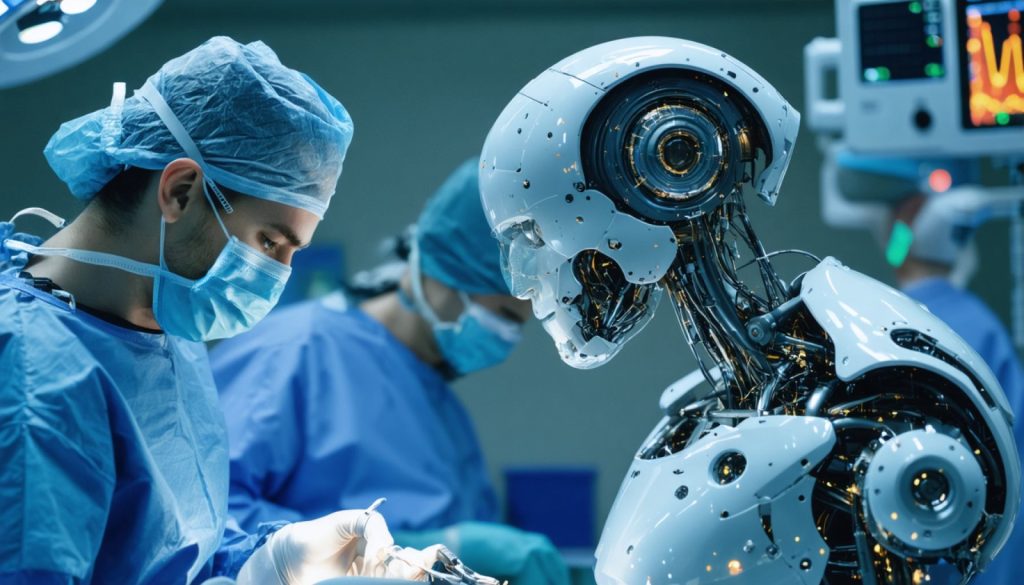
- AI-driven robotic systems revolutionize surgery by providing unparalleled precision and accuracy, guiding instruments with the finesse of a concert pianist.
- These robotic systems leverage advanced machine learning to constantly improve their dexterity and efficiency through learned experiences from countless surgical scenarios.
- AI-powered telemedicine dissolves geographical barriers, enabling surgeons to perform operations remotely, thereby democratizing access to life-saving procedures.
- The integration of predictive algorithms enhances surgical outcomes and reduces recovery times by transforming surgeries from reactive to proactive approaches.
- AI processes vast amounts of medical data at lightning speed, identifying patterns and potential complications to avert crises before they occur.
- Ethical considerations and rigorous oversight are crucial to maintaining trust in AI technologies within healthcare.
- AI enhances, rather than replaces, the human touch in surgery, emphasizing continuous improvement and collaboration between surgeons and intelligent machines.
- This dynamic partnership between AI and human surgeons promises a stronger, more responsive, and precise healthcare future.
The operating room bustles with anticipation as a new era of surgical innovation takes center stage. Welcome to the world where artificial intelligence (AI) meets robotic surgery, a fusion that promises to redefine healthcare’s most intricate procedures.
Gone are the days when surgeries relied solely on a surgeon’s steady hand. Today, AI-driven robotic systems offer unparalleled precision, guiding instruments with such accuracy that it seems almost otherworldly. Picture a delicate instrument maneuvering through the intricate web of veins and tissues with the finesse of a concert pianist. These robotic systems, equipped with advanced machine learning algorithms, learn and adapt from countless surgical scenarios, constantly improving their dexterity and efficiency.
Imagine a surgeon in Los Angeles commanding a robotic arm in Tokyo. Thanks to AI-powered telemedicine, geographical barriers dissolve, democratizing access to life-saving procedures. By leveraging deep learning, these systems analyze a vast treasure trove of medical data, drawing insights that refine surgical techniques. This capability not only enhances outcomes but also diminishes recovery times significantly. Patients rise from their hospital beds faster, their bodies bearing fewer scars and reduced trauma, courtesy of precision cuts and seamless sutures.
But what fuels this digital renaissance in surgery? The brilliance of AI lies in its ability to process data at lightning speed. It recognizes patterns hidden deep within datasets, patterns that would elude even the most experienced human eye. For instance, predictive algorithms assist in identifying potential complications before they arise, ensuring surgical teams act swiftly to avert possible crises. This predictive power transforms surgery from reactive to proactive, paving the way for personalized treatment plans.
However, the journey doesn’t come without scrutiny. As AI’s role in healthcare expands, it demands rigorous oversight to maintain trust. Ethical considerations and stringent testing ensure these technologies remain safe and effective. Surgeons become collaborators with these intelligent machines, designing and refining procedures with an eye toward continuous improvement. While AI delivers unprecedented precision, human judgment remains paramount, orchestrating these technological marvels with empathy and care.
The takeaway? AI’s integration into robotic surgery is not about replacing human touch; it’s about enhancing it. With this dynamic partnership, healthcare emerges stronger, more responsive, and incredibly precise. As AI continues to evolve, the potential for further advancements in surgery promises a healthier future for all. Embrace this transformation—because the most cutting-edge innovations are already at work, sculpting the future of medicine.
Unlocking the Future of Surgery: How AI-Driven Robotic Systems Are Revolutionizing Healthcare
The integration of artificial intelligence (AI) with robotic surgery marks a significant milestone in the evolution of healthcare, offering unprecedented precision and efficiency in surgical procedures. As these technologies continue to advance, understanding their full potential, possible limitations, trends, and applications becomes increasingly important.
How AI-Driven Robotics Transform Surgery
Real-World Use Cases
1. Complex Surgical Procedures: AI-powered robotic systems are ideally suited for intricate surgeries such as neurosurgery, where precision is paramount. These systems can assist surgeons in performing minimally invasive procedures, reducing risks associated with traditional surgeries.
2. Telemedicine in Surgery: Surgeons can operate from remote locations using AI-powered telemedicine platforms that control robotic arms in distant hospitals. This capability has expanded access to critical surgical interventions, particularly in underserved or rural areas.
Pros and Cons Overview
Pros:
– Precision and Reduced Trauma: AI-driven robotics that make precise incisions and minimize tissue damage result in faster recovery times and less postoperative pain.
– Data-Driven Insights: Machine learning algorithms offer predictive analytics that enhance surgical planning and patient-specific treatment plans.
– Global Collaboration: Surgeons worldwide can collaborate on cases in real time, leveraging AI’s analytical power for diagnosis and treatment strategies.
Cons:
– High Initial Costs: The deployment of AI-driven robotic systems requires substantial upfront investment, which may be challenging for smaller medical facilities.
– Dependency on Technology: As reliance on AI systems increases, there is a risk of diminished human expertise in manual surgical skills.
– Ethical and Privacy Concerns: Handling vast amounts of patient data necessitates stringent privacy measures to protect sensitive information.
Insights & Predictions
The adoption of AI in robotic surgery is poised to accelerate, with market forecasts predicting growth in the global surgical robotics sector, reaching over $16 billion by 2025. Advances in AI will likely drive developments in device miniaturization and mobility, broadening the scope of robotic applications in non-traditional surgical settings.
Market Trends
– AI Algorithms in Healthcare: The focus is now on developing AI algorithms that can support decision-making, offering potential in areas such as early diagnosis, patient monitoring, and custom treatment plans.
– Improved User Interfaces: Enhanced interfaces that allow for easier and more intuitive control of robotic systems are in development, aiming to simplify surgeon interaction with AI-driven tools.
Controversies & Limitations
While the transformative potential of AI in surgery is vast, the field faces several challenges:
– Regulatory Challenges: Ensuring AI-driven systems meet rigorous regulatory standards is crucial for public safety and trust.
– Human-AI Collaboration: Ensuring effective teamwork between AI systems and human surgeons remains a focal point, as human oversight is crucial for surgical success and ethical decision-making.
Actionable Recommendations
1. Stay Informed: Healthcare professionals should keep pace with the fast-evolving landscape of AI in robotic surgery by engaging in continuous education and training workshops.
2. Foster Collaboration: Cultivating partnerships between technology developers and healthcare providers will ensure that innovation aligns with clinical needs.
3. Evaluate Cost-Benefit: Hospitals should conduct thorough assessments when considering AI-integrated systems to determine potential operational efficiencies against the investment required.
For more on advancements in AI technology, visit Intuitive Surgical to explore their cutting-edge solutions and innovative outlook on robotic-assisted surgeries.
Embrace the future of surgical precision with AI-powered robotics, enhancing the capabilities of healthcare professionals worldwide.



